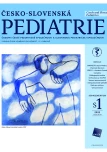Pityriasis rosea Gibert
Authors:
Konrád Pavel
Authors place of work:
Lasermed, Praha
; Kožní ambulance, Černošice
Published in the journal:
Čes-slov Pediat 2023; 78 (Supplementum 1): 30-32.
Category:
doi:
https://doi.org/10.55095/CSPediatrie2023/030
Summary
The article describes a common exanthematic disease typical of adolescence, pityriasis rosea Gibert. The significance of the name of the disease is explained and the historical implications of the origin of the name of the disease are clarified. The current view of its probable viral etiopathogenesis and its similarity to another exanthematous skin disease, exanthema subitum, are described. The prodromal stage of the disease and the clinical picture of the skin findings with characteristic seeding of lesions resembling „Christmas tree branches“ are described. The author‘s clinical pictures of the findings in individual patients with this disease are included. The possible relationship with COVID 19 is noted. The differential diagnosis is discussed, including the similarity to secondary syphilis, and the uncharacteristic histopathological picture of the disease is described. Finally, treatment options are discussed, with the caveat that the very common use of topical corticosteroids is not very effective and rather non-corticoid external therapy is recommended.
Keywords:
HHV-6 – pityriasis rosea – HHV-7
Zdroje
1. Braun-Falco O, Plewig G, Wolf H. Dermatológia a venerológia. Martin: Osveta, s.r.o. 2001: 486–488.
2. Čelakovská J. Choroby kůže vyvolané vláknitými houbami a kvasinkami. Dermatologie pro praxi 2018; 12(1): 20–24.
3. Štork J, et al. Dermatovenerologie. Praha: Galén 2008: 176–177.
4. Hercogová J. Klinická dermatovenerologie. Praha: Mladá fronta 2019: 294–295.
5. Neneman A. Pityriasis rosea in a patient with retrovirus infection and a history of syphilis and positive results of infection with hepatitis A virus, hepatitis B virus and hepatitis C virus. Postepy Dermatol Alergol 2017; 34(3): 276–278.
6. Veraldi S, Romagnuolo M, Benzecry V. Pityriasis rosea like eruption revealing COVID-19. Australas J Dermatol 2021; 62(2): e333–e334.
7. Fadrhoncová A. Farmakoterapie kožních nemocí. Praha: Grada 1999: 363– 364.
8. L eenutaphong V, Jiamton S. UVB phototherapy for pityriasis rosea: a bilateral comparison study. J Am Acad Dermatol 1995; 33: 996–999.
9. D rago F, Vecchio F, Rebora A. Use of high-dose acyclovir in pityriasis rosea. J Am Acad Dermatol 2006; 54: 82–85.
10. Sharma PK, Yadav TP, Gautam RK, et al. Erythromycin in pityriasis rosea: a double-blind, placebo-controlled clinical trial. J Am Acad Dermatol 2000; 42: 241–244.
Štítky
Neonatológia Pediatria Praktické lekárstvo pre deti a dorastČlánok vyšiel v časopise
Česko-slovenská pediatrie

2023 Číslo Supplementum 1
- Realita liečby bolesti v paliatívnej starostlivosti v Nemecku
- Gastroezofageální reflux a gastroezofageální refluxní onemocnění u kojenců a batolat
- Využití hodnoticích skóre a objektivních nástrojů při léčbě astmatu
- Nech brouka žít… Ať žije astma!
Najčítanejšie v tomto čísle
- Pityriasis rosea Gibert
- Infekce vyvolané respiračními syncytiálními viry – epidemiologie, klinický obraz, diagnostika, možnosti prevence a léčby
- Tularemie – série kazuistik
- Tularemie přenesená klíštětem u čtyřleté dívky
